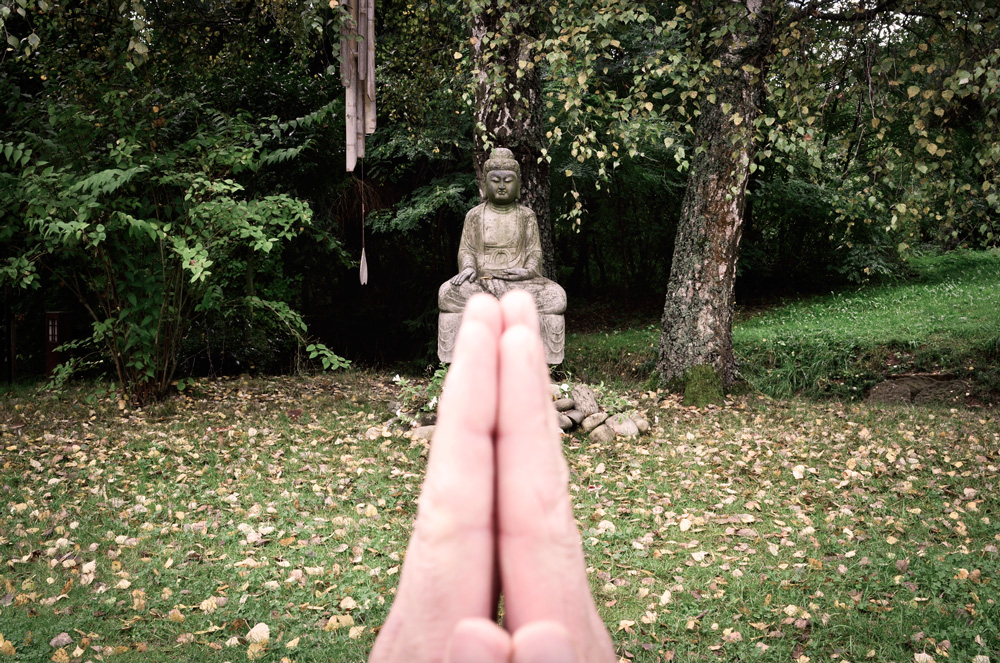You’d think it would be a piece of cake. I had been inspired to begin two bows a day—one at the beginning of the day and one at the end, in what the late Rev. Koyo Kubose called “Everyday Gassho.” The morning bow would be a “harmony gassho,” to mark my intention to help others and to play my small part in the symphony of the day ahead. The evening bow would be a “gratitude gassho.” For a Buddhist teacher who runs a temple, already bows multiple times a day, and prides herself in doing what she says she’s going to do, what could go wrong?
During week one, I failed to make a single Everyday Gassho. Once or twice I thought of my new bowing practice when I was outside the temple or lying in bed in the middle of the night: Oh, the gasshos! I had originally set my intention during a book group I was running, and if I hadn’t felt the need to report my progress to my students the week after, maybe I would have forgotten the whole project. I did report back, confessing my failure and vowing to try again.
The second week was marginally better. I managed two morning gasshos, but no evening gasshos. I started to get curious. What was going on? Why was it so difficult? Was I unconsciously rebelling?
During discussion at the next book group, I thought I’d figured out why I was struggling so much with this seemingly simple practice. It was the word “harmony,” which Rev. Kubose used to describe the morning bow. The word just wasn’t inspiring me. One of the students was a harpist and loved the word, but to me it sounded weak somehow; it didn’t fire me up. I am a devotional Pure Land Buddhist and although I read devotion in between the lines of Rev. Kubose’s—and his father Rev. Gyomay Kubose’s—teachings, their mission was to bring Buddhism to America in a way that suited Americans. They often had a secular tang. How could I make this practice mine?
I went back to reread what Rev. Kubose had written about the morning gassho.
The underlying sentiment of the ‘harmony gassho’ is that you will try your best to have a spirit of cooperation with others, and always be as calm and patient as possible. The seed of this sentiment will gradually blossom into an understanding that can be called wisdom.
I got it. The morning’s gassho was offering ourselves to the Buddhas, to do their work. If I thought of my morning gassho as handing myself over to the safe hands of the Buddhas, of allowing the Buddhas to do what they wanted with me, then I felt fired up. Christians might say, “Your will, not mine.” Surrendering my small ego with its self-protective grasping to the unknown wisdom of the cosmos is something I can get behind.
I decided to start again with this new understanding. Rather than referencing the word “harmony,” I thought of “handing myself over.” The following week I bowed more, and by the end of the week, I could acknowledge that the word “harmony” felt better to me than it had before. (I didn’t get to know Rev. Kubose very well before he died in March 2022, but from the time I did spend with him, I was pretty sure that he’d be chuckling fondly at me. “Look at her, making it so complicated! Just bow!”)
Finally, almost a month into the practice, I did just bow. I often did my harmony gassho to the big Buddha in the temple garden, before my morning nembutsu. Sometimes I forgot about the gratitude gassho until I got to the bedroom, but I have a shrine there too and so I often thank this small golden Buddha for everything I’ve received during the day. They are short moments, but they are poignant.
I will be interested to see how this practice develops as I continue to incorporate it into my days. Here is what Rev. Kubose said about the gratitude gassho:
The underlying sentiment accompanying the Gratitude Gassho is an awareness of interdependency—that one is supported by nature, by other people, by everything. There is a feeling of “counting one’s blessings,” of “grace,” or of “how grateful I am.” The seed of this sentiment will naturally blossom and be expressed in compassionate ways.
This is certainly my experience of practice. As I put myself into good conditions, by having a short daily meditation or chanting practice, by making a conscious effort to spend time in nature, by getting together to practice with others a couple of times a week, these seeds will “naturally blossom.” As a result, I will be more able to be kind to the planet, to other living beings, and to myself. As we recite at the end of every practice session here at the temple:
Blessed by Amitabha’s light
may we care for all living things
and the holy Earth.
This morning I thought about the gasshos as “please” and “thank you.” In the morning I ask the Buddhas to help me live in harmony with others and our planet, and in the evening I say thank you for all I have received. I also think about them in the language of offerings: in the morning I offer my body, my unique qualities and my energy to be used to do good, and in the evening I take time to acknowledge the many offerings I have received in return. In breath, out breath. I am acknowledging the cycle of life that continues every day, every hour, and every second. I am connecting myself to something bigger. It feels good.
♦
Find Rev Koyo Kubose’s instructions for the Everyday Gassho here.
Read more about Satya Robyn here.
Thank you for subscribing to Tricycle! As a nonprofit, we depend on readers like you to keep Buddhist teachings and practices widely available.
